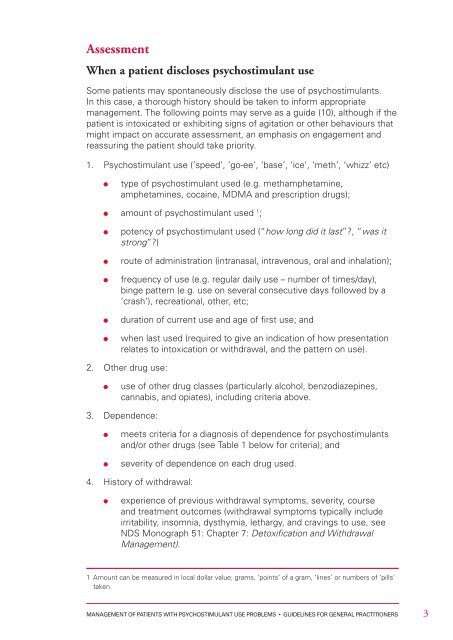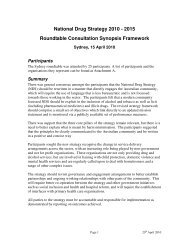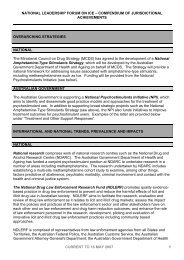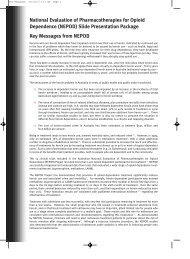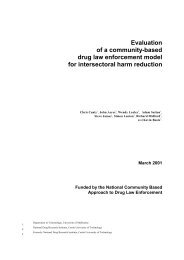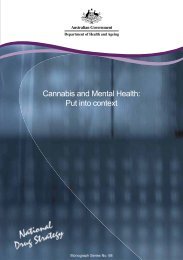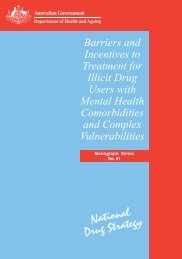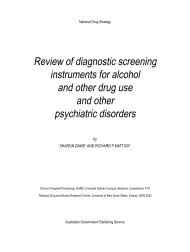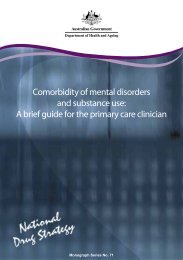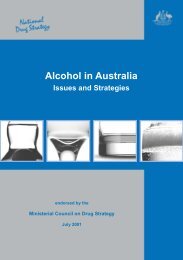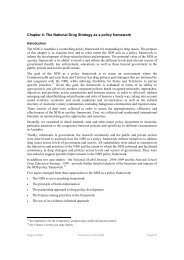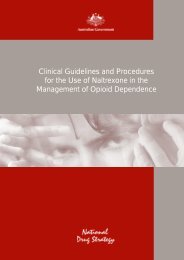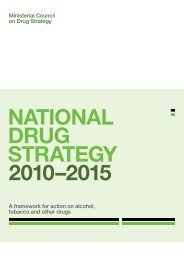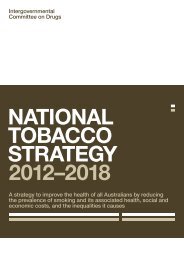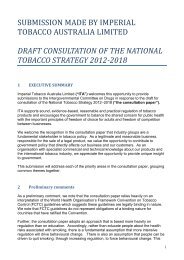Management of patients with psychostimulant use problems
Management of patients with psychostimulant use problems
Management of patients with psychostimulant use problems
You also want an ePaper? Increase the reach of your titles
YUMPU automatically turns print PDFs into web optimized ePapers that Google loves.
Assessment<br />
When a patient discloses <strong>psychostimulant</strong> <strong>use</strong><br />
Some <strong>patients</strong> may spontaneously disclose the <strong>use</strong> <strong>of</strong> <strong>psychostimulant</strong>s.<br />
In this case, a thorough history should be taken to inform appropriate<br />
management. The following points may serve as a guide (10), although if the<br />
patient is intoxicated or exhibiting signs <strong>of</strong> agitation or other behaviours that<br />
might impact on accurate assessment, an emphasis on engagement and<br />
reassuring the patient should take priority.<br />
1. Psychostimulant <strong>use</strong> (‘speed’, ‘go-ee’, ‘base’, ‘ice’, ‘meth’, ‘whizz’ etc)<br />
type <strong>of</strong> <strong>psychostimulant</strong> <strong>use</strong>d (e.g. methamphetamine,<br />
amphetamines, cocaine, MDMA and prescription drugs);<br />
amount <strong>of</strong> <strong>psychostimulant</strong> <strong>use</strong>d 1 ;<br />
potency <strong>of</strong> <strong>psychostimulant</strong> <strong>use</strong>d (“how long did it last”?, “was it<br />
strong”?)<br />
route <strong>of</strong> administration (intranasal, intravenous, oral and inhalation);<br />
frequency <strong>of</strong> <strong>use</strong> (e.g. regular daily <strong>use</strong> – number <strong>of</strong> times/day),<br />
binge pattern (e.g. <strong>use</strong> on several consecutive days followed by a<br />
‘crash’), recreational, other, etc;<br />
duration <strong>of</strong> current <strong>use</strong> and age <strong>of</strong> first <strong>use</strong>; and<br />
when last <strong>use</strong>d (required to give an indication <strong>of</strong> how presentation<br />
relates to intoxication or <strong>with</strong>drawal, and the pattern on <strong>use</strong>).<br />
2. Other drug <strong>use</strong>:<br />
<strong>use</strong> <strong>of</strong> other drug classes (particularly alcohol, benzodiazepines,<br />
cannabis, and opiates), including criteria above.<br />
3. Dependence:<br />
meets criteria for a diagnosis <strong>of</strong> dependence for <strong>psychostimulant</strong>s<br />
and/or other drugs (see Table 1 below for criteria); and<br />
severity <strong>of</strong> dependence on each drug <strong>use</strong>d.<br />
4. History <strong>of</strong> <strong>with</strong>drawal:<br />
experience <strong>of</strong> previous <strong>with</strong>drawal symptoms, severity, course<br />
and treatment outcomes (<strong>with</strong>drawal symptoms typically include<br />
irritability, insomnia, dysthymia, lethargy, and cravings to <strong>use</strong>, see<br />
NDS Monograph 51: Chapter 7: Detoxification and Withdrawal<br />
<strong>Management</strong>).<br />
1 Amount can be measured in local dollar value; grams, ‘points’ <strong>of</strong> a gram, ‘lines’ or numbers <strong>of</strong> ‘pills’<br />
taken.<br />
MANAGEMENT OF PATIENTS WITH PSYCHOSTIMULANT USE PROBLEMS • GUIDELINES FOR GENERAL PRACTITIONERS<br />
3


